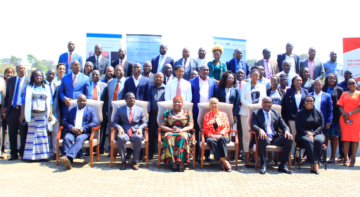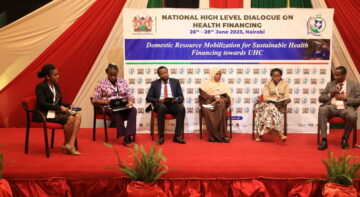Blogs

Following the 2017 General Election, Kenya is now witnessing the second term of a devolved system of government, which was enacted by the 2010 Constitution of Kenya. The first term was characterised by several challenges including constant wrangles between Governors, Senators and members of county assemblies (MCAs) in seeming power struggles and alleged misappropriation of funds at the county level. Some Kenyans have joked that in an attempt to devolve governance, we instead devolved corruption.
Interestingly, the county government leadership has owned up to the fact that their first term was more about setting up structures and finding their footing. With the second term, it is now time for them to deliver on projects and improve the lives of their people.
During the 2018 Legislative Summit convened by the Senate and the County Assembly Forum between 22-24 May in Mombasa County, national government representatives, Senators, MCAs, other government officials, development agencies and civil society organisations deliberated various issues of importance to the country’s development.
Top on the discussion list was how the national and county governments are going to collaborate in delivering on the promise of the « Big Four’ Agenda, a brainchild of the current national government. The « Big Four’ priority areas as announced by President Kenyatta in December 2017 are investments in Universal Health Coverage (UHC) to ensure access to quality and affordable healthcare for all Kenyans; quality and affordable housing; food security to ensure all Kenyans are well fed; and industrialisation to promote value addition to products, whilst creating employment opportunities for the country’s working-age population, by 2022.
Collaboration is key
As noted by the Presidency on several occasions, the national government is seeking partnership with county governments and the private sector to achieve the « Big Four’ Agenda, more so due to the resource-intensive nature of the investments needed to achieve the set priorities. Speaking at the Legislative Summit, the Governor of Uasin Gishu County, H.E. Jackson Mandago pointed out that the national government cannot succeed in achieving the ‘Big Four’ without involving counties, and so far, there has been good synergy between both levels of government. He, however, cautioned that there is need for legislation to implement some of the key actions towards realisation of the ‘Big Four’ priorities. In addition, as pointed by Hon. Joshua Kiptoo, Speaker, Nandi County Assembly, although the These roles should therefore be clarified for smooth implementation of the « Big Four’ Agenda.
The greatest benefit of devolution is that county governments can now tailor local development investments to the needs of the people. As such, the Cabinet Secretary, National Treasury, Mr. Henry Rotich, urged county assemblies to define priorities aligned with the ‘Big Four’ Agenda. This will ensure that county governments are in sync with efforts at the national level. Specifically, county assemblies need to ensure that the County Integrated Development Plans (CIDPs) align with « Big Four’ priorities.
Further, in order to facilitate smooth collaboration between the national and county governments, there is need to close the current capacity gaps among those charged with key functions such as developing legislation and budgeting. Sen. Mahamud Mohamed Maalim, the Chairperson, Standing Committee on Finance and Budget, emphasised this need, as county governments cannot run effectively if the existing capacity gaps prevail.
The budget question
The priorities of the ‘Big Four’ Agenda are quite resource-intensive and have been embedded in the Third Medium Term Plan (MTP III) 2018-2022 of the Kenya Vision 2030. As such, the 2018 Budget Policy Statement (BPS) published by the National Treasury, acknowledges the impending financial burden. The BPS, therefore, outlines measures such as partnering with the private sector through Public-Private Partnerships in order to meet the set goals and objectives. The National Treasury also cites ‘gradually reducing’ non-priority expenditures. Despite the existing efforts to bridge the financial gap, a problematic reality is that about 85% of the annual budget is allocated to the national government while 15% is allocated to county governments, which curtails implementation efforts, as much of the work is taking place at the county level.
At the county level, discussions at the Legislative Summit revealed that the current budgets for counties have not been realigned to the « Big Four’ Agenda and this will be done in the budgets for the next financial year. This poses a challenge in how counties shall implement the set priorities without coherent budgetary provisions. However, as indicated by Sen. Mahamud, nothing stops counties from undertaking some of the functions towards the realisation of the ‘Big Four’ using existing resources. In addition to budget realignment, the CIDPs will have to be realigned with the ‘Big Four’.
Delivering on the promises
As noted earlier, the second term of the devolution system of government does not have room for detractions. Kenyans cannot afford it anyway. County governments, therefore, need to roll up their sleeves and get to work. The national government should ensure county governments have the tools to deliver on the promises of the ‘Big Four’. This means capacity gaps in legislation, budgeting, and other critical areas should be plugged urgently. CIDPs should also be realigned to the ‘Big Four’ without further delay, failure to which the priorities will only look good on paper, but nothing on the ground. Finally, caution should be taken not to overlook and undermine other critical sectors such as education, tourism, trade, infrastructure, and so forth, while in pursuit of the ‘Big Four’.
Related Posts




